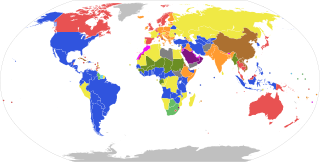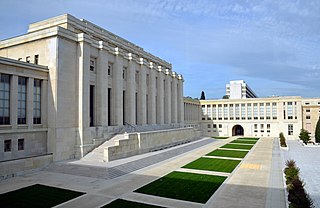Use
Government and politics
| Part of the Politics series |
| Party politics |
|---|
| |
Coalition government is an alternative model to a majority government, the latter being prevalent in winner-take-all first-past-the-post electoral systems that favor clear distinctions between winners and losers. [9] [10] Not only can coalitions of legislative groups form governments in parliamentary systems, they can also form in divisions of power.[ clarification needed ] Most typical analyses of coalitions in politics deal with the formation of multiparty cabinets in parliamentary regimes. [11] In Germany, every administration has been a multiparty coalition since the conclusion of the Second World War –an example of coalition government creation in a parliamentary system. When different winning coalitions can be formed in a parliament, the party composition of the government may depend on the bargaining power of each party and the presence or lack of a dominant party. [11]
Coalitions are similar to parliamentary groups. Fluid coalitions, which change with each vote, exist in the European Parliament [12] and Swiss parliament to pass legislation.
International relations

 Brazil,
Brazil,  China,
China,  India,
India,  Mexico,
Mexico,  Russia and
Russia and  South Africa: BASIC, BRICS, G5 and IBSA
South Africa: BASIC, BRICS, G5 and IBSA The temporary collaboration of two or more separate parties with a set goal and common purpose can be viewed as a coalition in international relations. [13] Coalition competitions are represented in international political dynamics. [14] A coalition can be an ad hoc grouping of nations united for specific purposes. [15] Although persons and groups form coalitions for many and varied reasons, the most common purpose is to combat a common threat or to take advantage of a certain opportunity, resulting in the often temporary nature of coalitions. The common threat or existence of opportunity is what gives rise to the coalition and allows it to exist as all parties involved see the benefit in working together. Such collaborative processes allow the actors of the coalition to approach a common goal or accomplish the same task. [16] The behavior and dynamics of coalitions in international relations are created by commonalities and differences within the groups joining together. Rationality, group dynamics, and gender are all contributing factors of coalitional behaviors in an international security framework. [17]
Economics
Economic agents can form coalitions. [18] When a coalition is formed around economic goals, the reasoning is financial. In economics, when two opposing sectors, such as a buyer and seller or two sellers, come together, it can be thought of as a coalition in the denotative sense, as the two groups come together temporarily to achieve a goal. [19] One example would be the 1997 deal between Microsoft and Apple. The deal consisted of Microsoft rescuing the then-struggling Apple with a cash infusion of $150 million. [20] Unions can be viewed as coalitions of workers, usually of the same job sector. When the agents considered are countries, the formation of an international treaty (e.g. trade agreements or international environmental agreements) can also be seen as a coalition. In economics, a coalition's formation and its stability is mostly studied using game theory.
Civil society
In civil society, a coalition denotes a group effort or a population of people coming together who believe strongly in their cause. The term also describes alliances between civil society organizations, such as labor unions, community organizations, and religious institutions. In France for example, workers from different sectors and unions band together to aid each other in communicating a point. This coalition of unions is often very effective as it can cause massive inconvenience to the country. [21] The formation of coalitions such as the Community-Labor Coalition have proven to be an important strategy for social change in many contexts. [22] In social groups, a coalition often forms from private citizens uniting behind a common goal or purpose, sometimes within a coalitional identity. Many of these private citizen groups form grassroots organizations, such as the Christian Coalition, which is the largest grassroots political group in the US. [23] Activist groups in civil society are also viewed as coalitions for their respective cause. These activists are joined together by their belief in what they want to achieve or accomplish.
Military
Military coalitions can be built and united under a singular power by multiple states and governments. They are fluid in terms of membership –not only does a country not have to have been a traditional ally to join a coalition, but nations can join, vary their contributions and caveats, withdraw, and be replaced by new members as the situation changes or national agendas change. [6] The expansion of assets accessible to member nations to perform military operations is a crucial attribute of coalitions. In many ways, coalition warfare serves to make the crafting of a peace more difficult than winning the war itself. [24] An example of such a coalition happened after World War I during the 1919 Versailles Peace Conference, when the Allied powers attempted to reach a peace agreement.
Examples of military coalitions include the Coalition of the Gulf War, when George H. W. Bush ended Saddam Hussein's aggression in the Middle East by enlisting and leading a military coalition in the 1991 Gulf War's Operation Desert Storm [25] as well as his son George W. Bush's efforts in the Coalition of the Willing, a phrase employed during the 2003 campaign for the war in Iraq led by the US and its allies. A contemporary example is the United Nations coalition that intervened in the 2011 Libyan Civil War against Muammar Gaddafi. For coalitions to be effective in principle or in action, participating nations have tended to require a single overpowering threat –perhaps to freedom or a way of life or a crucial national interest –or the presence of a single despotic figure or regime whose continued existence is considered not only abhorrent to the generality of nations but also destabilizing to the region or world order. [6]
Mathematics
In mathematics, the term coalition is linked to an equation which uses the coalition model for exponential population growth. This analytical equation was first published by mathematician Pierre François Verhulst in 1838 to allow for the approximation of the world's population at a given time by applying differential and integral techniques. [26]










